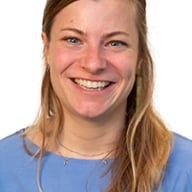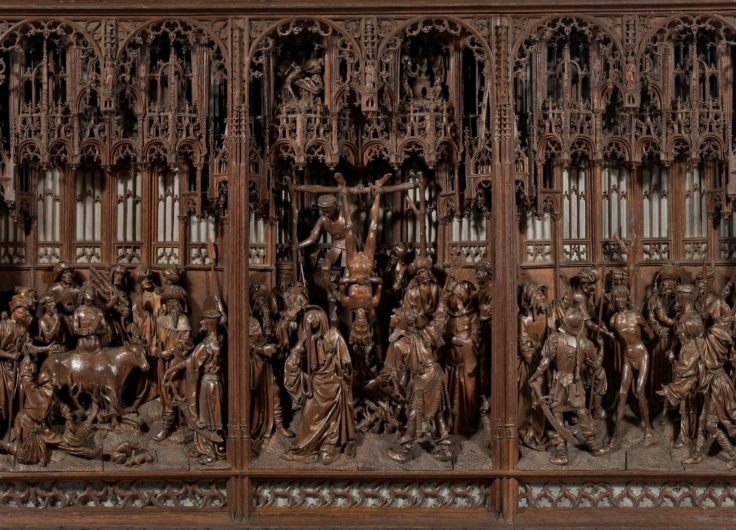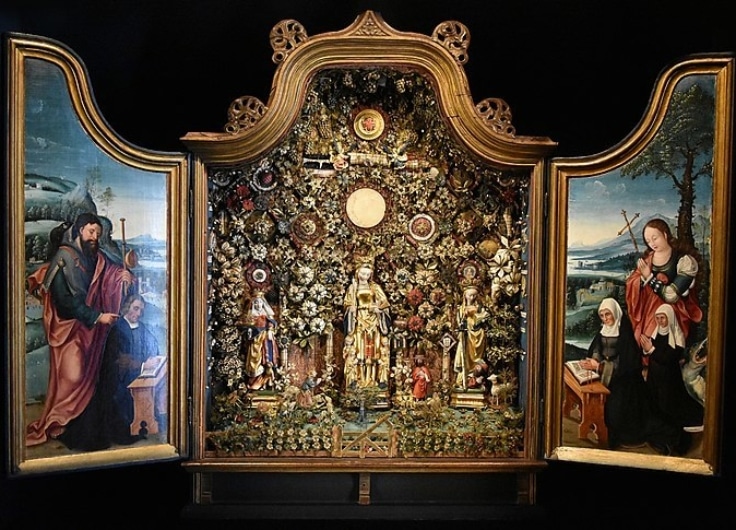Magnificent Showcases. Flemish Retables Collected in Digital Corpus
Sculpture in the former Duchy of Brabant in the late fifteenth, early sixteenth century was just as influential as the paintings of the Flemish Primitives. Retables – or altarpieces – were exported to the whole of Europe. The Flemish study centre Illuminare (KU Leuven) and the Netherlands Institute for Art History (The Hague) have produced a digital inventory of these magnificent examples of late medieval sculpture, the Digital Corpus of Flemish Retables.
In the late fifteenth and early sixteenth century, sculpture in the former Duchy of Brabant, particularly in Brussels and Antwerp, was among the absolute best in the world. So far, however, there has been little academic research into late medieval sculpture from the Low Countries. It has clearly been overshadowed by the study of the paintings of the same period, the well-known works of the Flemish Primitives. Nonetheless, it is clear from the large numbers of sculpted retables that were exported to every part of Europe, from both Brabant and the Duchy of Flanders, that Flemish sculpture was equally, if not more, influential.
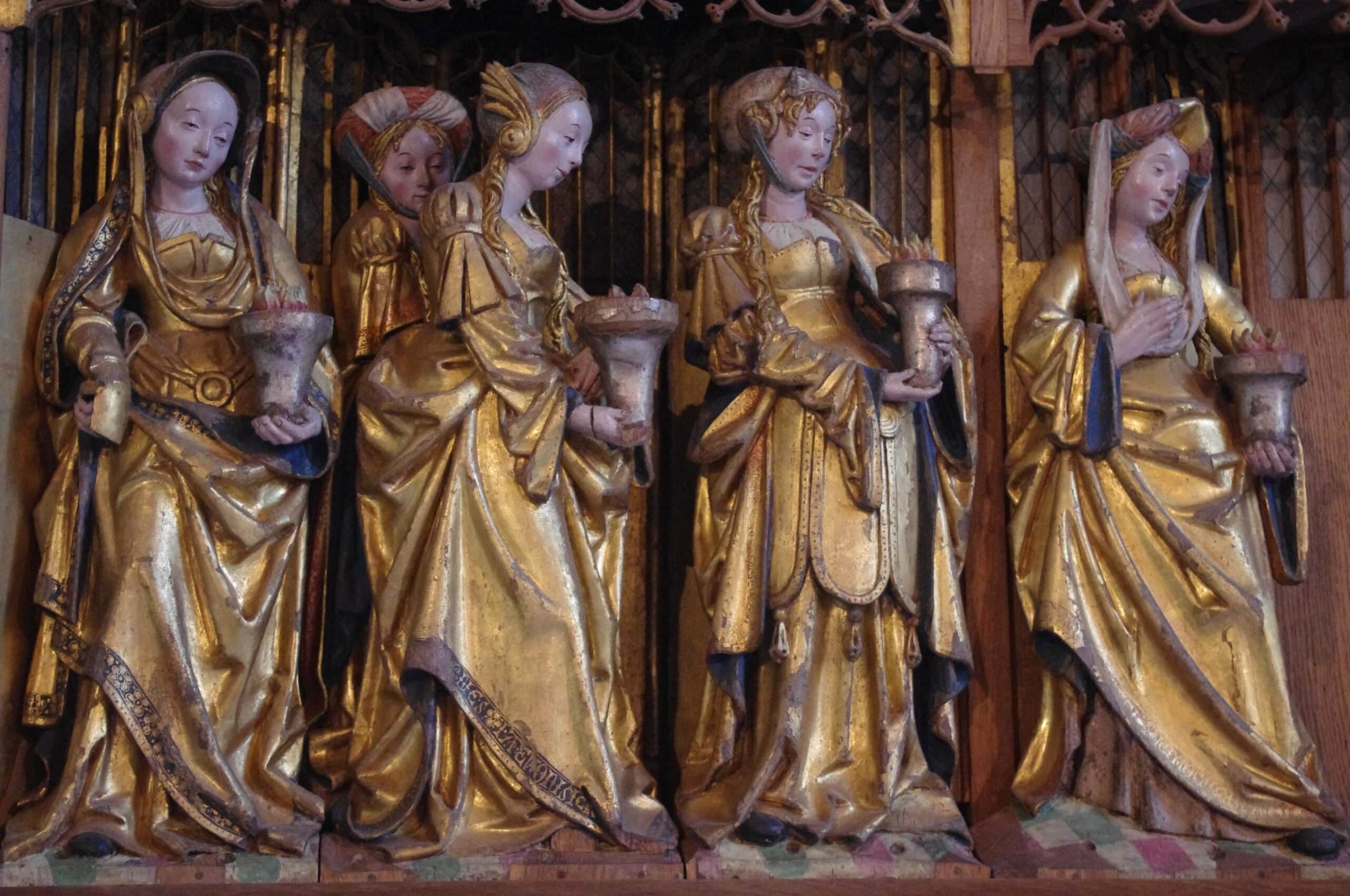 Passion retable at Vaksala, Uppland (Sweden), detail: the five wise Virgins, Antwerp marks, c. 1505-1515
Passion retable at Vaksala, Uppland (Sweden), detail: the five wise Virgins, Antwerp marks, c. 1505-1515© Hannah De Moor
Retables are wooden cabinets containing wooden – often polychromed and gilded – pictures or groups of pictures. The wooden cabinet can be closed with panels, which may be decorated with paintings or carvings. Usually, the cabinet and the panels are divided into several compartments, showing the different stages of a story in pictures. The life of Christ or the Virgin Mary is usually the main subject, or sometimes the life of a saint. Retables were erected on the high altar or side altars of a church and were opened only occasionally, during the celebration of the Eucharist or on religious holidays.
With their feeling for picturesque anecdotes, the sculpted scenes look almost like theatre scenes
Retables from Brabant and Flanders were widespread because of their exceptionally high quality, a quality that manifested itself in the sculptors’ impressive eye for detail. Besides the faces, posture and clothes of the main figures, the lawns, trees, interiors, churches and houses were also carved with the greatest artistic refinement. With their feeling for picturesque anecdotes, the sculpted scenes look almost like theatre scenes. Emotion and poignancy are central. So-called masonry cutters adorned the scenes with carefully applied architectural decoration. Then the polychromers applied colour, increasing the sense of drama. They covered the faces of the protagonists with a layer of pale pink, and painted tears on Mary’s face in pictures of the Descent from the Cross, for example. The dominance of gold on the figures’ clothing ensured that the retables functioned as magnificent showcases, but the magnificence was only visible when the painted panels – which were the responsibility of the painters – were opened.
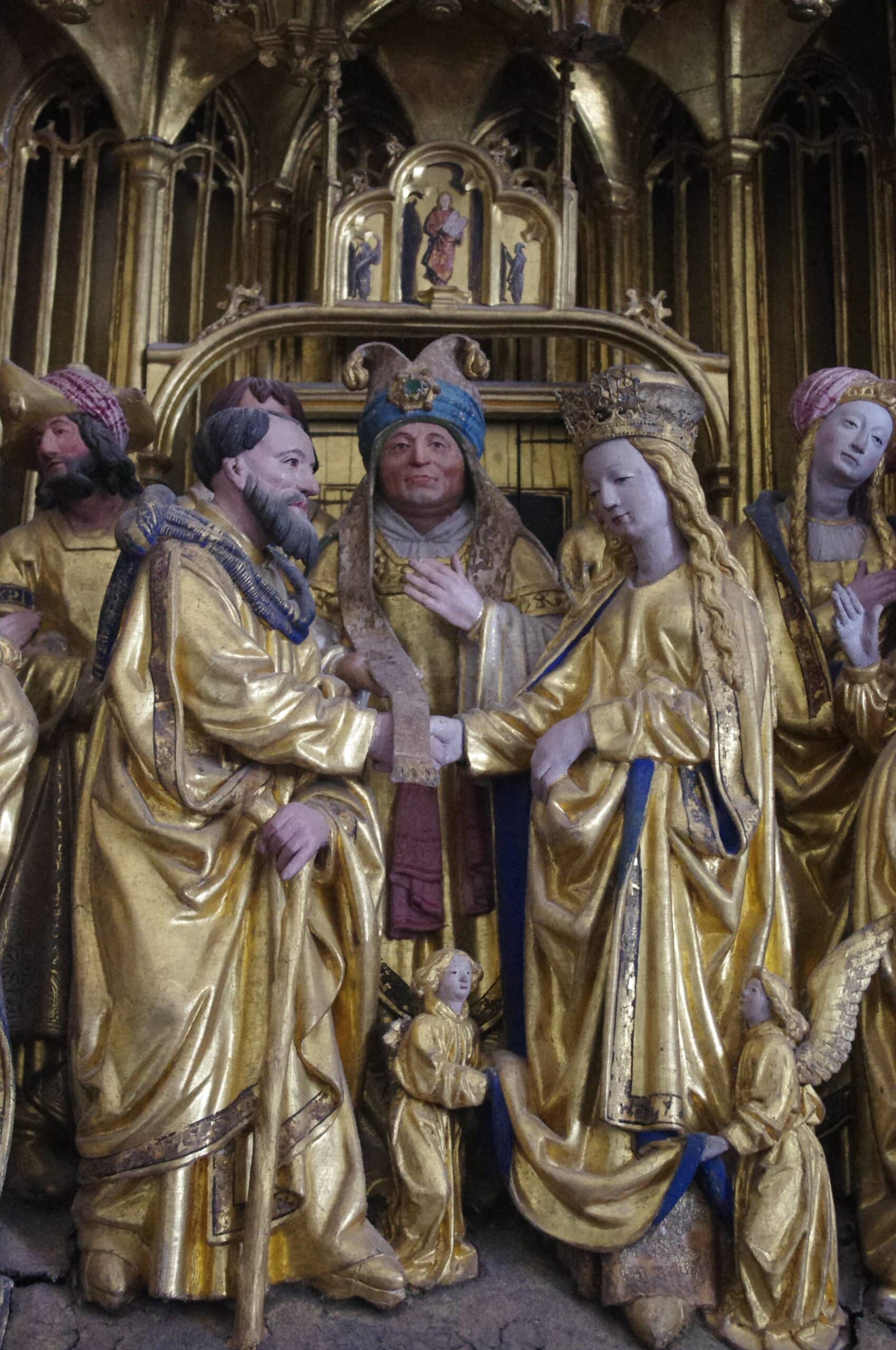 Retable of the Virgin in Skepptuna, Uppland (Sweden), detail: the marriage of Mary, Brussels marks, c. 1515-1520
Retable of the Virgin in Skepptuna, Uppland (Sweden), detail: the marriage of Mary, Brussels marks, c. 1515-1520© Hannah De Moor
The most famous retable is the Saint George Altarpiece, which once stood in the Chapel of Our Lady Outside the Walls, in Leuven. Today the artwork is preserved by the Art & History Museum in Brussels. The altarpiece depicts the life of Saint George. Sculptor Jan II Borman (? – ca. 1521), the head of a successful workshop in Brussels, signed the work by carving his name IAN on the sheath of one of the protagonists’ swords. A document from 1513 mentions him as the best carver of images and, indeed, that seems to be correct. The carving on the retable is unequalled in quality.
Wood carvings from Brabant and Flanders were appreciated far beyond their borders. The large clusters of retables that have been preserved in Germany, France, the Baltic Sea area (especially Poland), the Iberian Peninsula, England and Scandinavia are proof of that. Nonetheless, those retables that have survived are only a fraction of the vast number of altarpieces that originally adorned the altars in late-medieval churches. Religious disputes, fatal fires and brutal thefts were responsible for many of the retables being lost. Moreover, many churches put their retables up for sale, due to financial problems or radical changes to church furnishings.
Wood carvings from Brabant and Flanders were appreciated far beyond their borders
There is still no decent standard work on all the surviving retables. Illuminare, the Centre for the Study of Medieval Art at KU Leuven, and the Netherlands Institute for Art History in the Hague (RKD) are changing that now. Thanks to a generous gift from the estate of Schoufour-Martin, Illuminare and the RKD have been able to realise the dream of the previous generation of art historians, the compilation of a Corpus of Flemish Retables. In the 1970s, Hans Nieuwdorp, Herman De Smedt and Ghislaine Derveaux-Van Ussel worked hard to document the surviving retables. The work of these pioneers has yielded some conclusive insights and publications but, unfortunately, they were unable to realise the Corpus that was their goal. Illuminare looks after the documentation of retable specialist Hans Nieuwdorp (°1944), while the RKD watches over the research archives of Herman De Smedt (1927-2009) and Jaap Leeuwenberg (1904-1978). De Smedt and Leeuwenberg were also experts in medieval sculpture. By digitally collating these three prominent collections, Illuminare and the RKD have compiled an inventory of no less than 369 retables from Brabant and Flanders, as well as a few from the Northern Netherlands.
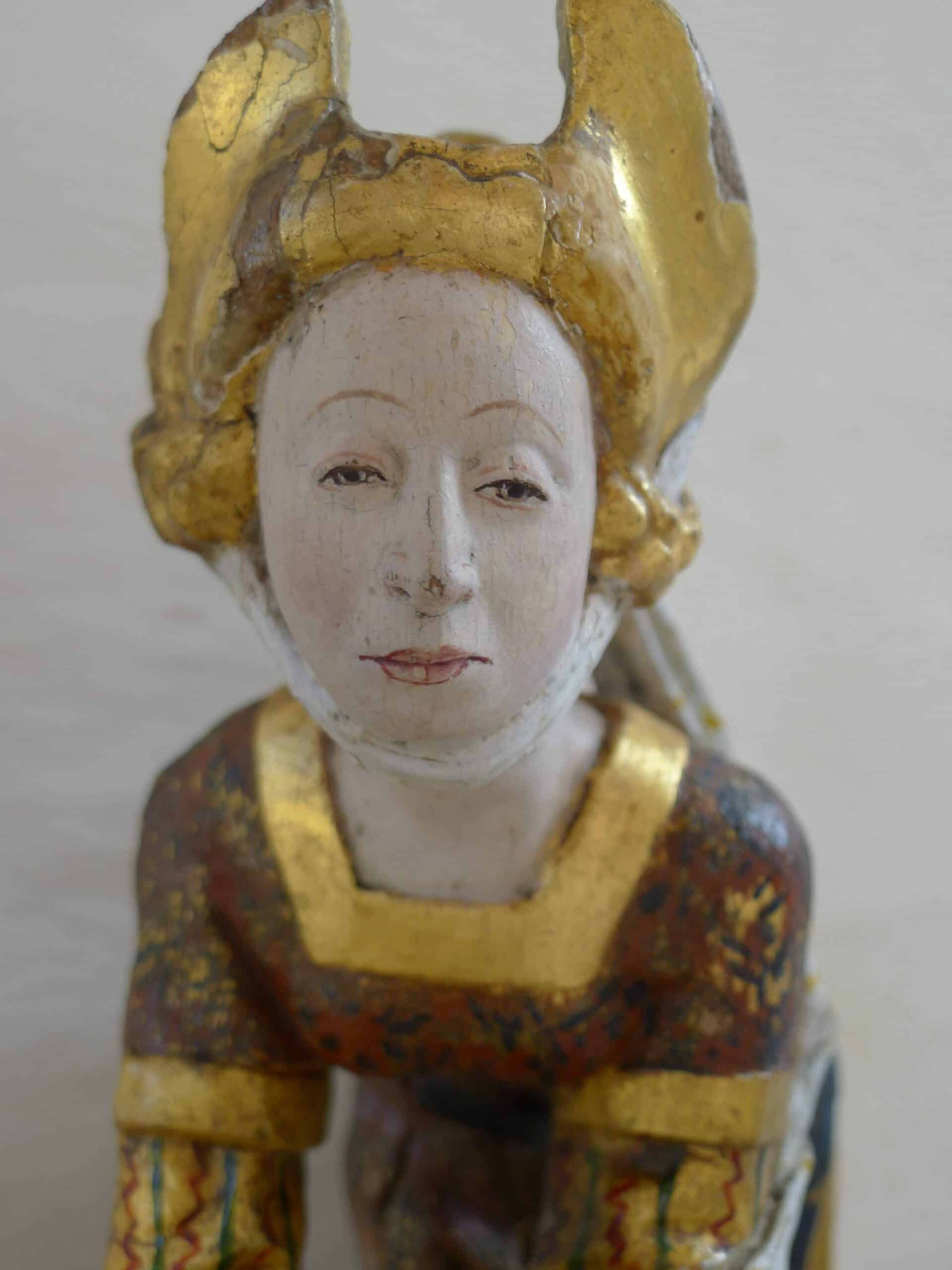 Passion retable in Bro, Uppland (Sweden), detail, Brussels marks, c. 1515-1520
Passion retable in Bro, Uppland (Sweden), detail, Brussels marks, c. 1515-1520© Maria Ihrsén, Pictor målerikonservering AB, Stockholm, Sweden
This digital resource, made available by Illuminare and the RKD, will help art historians and other interested parties in their research into our magnificent medieval heritage. Before the existence of this inventory it was a case of guessing the exact number of retables preserved. Now the handy online format makes it possible to group the artworks by chronology, geography, iconography or attribution. As a result, visitors can easily compare the retables, so that previously unseen artistic links become apparent, leading, amongst other things, to new hypotheses about the artists involved. For instance, the main scenes in the retables of Veckholm, By, Nordingrå and Ytterenhörna demonstrate a remarkable number of similarities in execution. That teaches us more about the production process of the artworks. It is possible that such scenes with popular motifs were made in advance in relatively large numbers.
The database is freely accessible and can be consulted at www.rkd.nl.
Literature
- Iris Ippel, ‘Jaap Leeuwenberg (1904-1978). Brede blik, scherp oog’, (Broad vision, keen eye), RKD Bulletin 2017, no. 2, pp. 3-13
- Suzanne Laemers, ‘Herman J. De Smedt (1927-2009), een levenslange passie voor retabels’, (a lifelong passion for retables), RKD Bulletin, 2010, no. 2, pp. 14-26
- Suzanne Laemers, ‘Digitaal Corpus Vlaamse Retabels’, (Digital Corpus Flemish Retables), RKD Bulletin, 2016, no. 2, pp. 20-23
- Margreet Wolters, ‘MARKS ON ART database’, RKD Bulletin, 2016, no. 2, pp. 24-28

